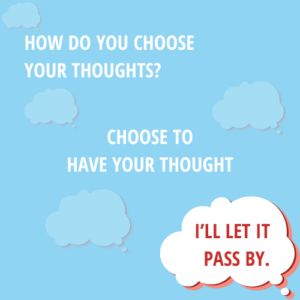How do you choose to have your thought or let it pass by?
You can decide whether to engage in your thoughts or to let them pass by. Just because you have a thought – it doesn’t not mean that you have to agree to it, that you have to engage with it or that it is helpful or rational. Most negative thoughts come into our heads because of our fears and because it is our habit to have them. It is a bit like our mind is a jukebox that is programmed to play on random our most popular (or cruel to self) thoughts.
So how do you practise not reacting to your thoughts? First of all, the key is to decide which thoughts you choose to keep, and which you choose to let pass by (down your river of consciousness). You might like to think about them as the thoughts you are choosing to dance with.
I’ve found the sushi train analogy to work well with clients. Here it is.
- When you are seated at a sushi train restaurant, you look at the sushi as it comes along the conveyor belt, then see something you want to choose. You decide if it is what you want. You are not obliged to take all of the sushi and eat it all just because it is coming past you. No, you are selective. And if the sushi does not look of quality, you do not choose it. It is the same with your thoughts: you watch your thoughts come along the river, like the sushi train, and you respond to your thoughts with skill. You can choose to observe the thought, and let it pass, or choose to engage and allow the thought into your mind and your world.
Some tips on how to choose your thoughts
1.Realise the thought is not necessarily fact or true. You do not have to agree with the thought; you do not even have to engage with the thought. You do not need to pick up the thought. You can just observe the thought and let it float past.
2. You decide if the thought is factual and true, and whether it is helpful or dysfunctional. Consider whether the thought is quality and a keeper or whether you will say, ‘Pass’. You can even decide that the thought is true and reasonable, but it is not what you want to engage in at that moment. It’s not a good time. For example, you might be sad or infuriated over a recent break-up but you have done a lot of processing of this and you do not want to keep going in circles; it is time to move on and get him/her out of your head. Or you are about to go to work and it is not a good time to get upset. So you can observe your break-up thought and leave it alone in the river, and let it float by. You can observe the thought and acknowledge it, but you do not need to pick it up and absorb it then and there.
Another example is that you might realise you are anxious about starting a new job. You realise you are riddled with self-doubt; these thoughts are not helpful, and you realise they are mainly fear based, highly self-critical and not true. So as these thoughts inevitably pop up, you decide to acknowledge the thought but not engage in it. You move to create a distraction, perhaps with the task you are doing, or with a replacement positive thought (Everyone is nervous on their first day, everyone starts off with lots to learn on the job, I can’t get it all right straight away).
3. If the thought is a No thanks, I’ll pass on this one, then you do not engage with it and you move on to your next thought. Either your next thought will be there ready to go, or you find a distraction. Strangely, just acknowledging a thought is usually enough to have it move along (check out the weirdly effective ‘dot’ experiment). If your unwanted/unhealthy thought remains in front of you, however, then focus on something else – distract yourself – think of something else. This needs to be something that keeps you busy and uses your brain, such as a brain puzzle game or tidying the cutlery draw – whatever works. Whatever comes to mind or is in front of you.
The mind is like a television: if you change to another thought or focus, you have changed channels and the previous channel (or thought) is no longer playing. It is true that this unwanted / unhealthy thought can (and will) pop back up again. That is okay; it just means that you continue with this approach each time. When we choose not to engage with our thoughts and we do not fuel them, they become weaker over time. We also strengthen the mind’s ability to concentrate and to be calm.
A few pointers to cheer you on…
1.Take comfort; no one can control what pops into their heads – it is on random play. It’s not just you. Everyone is in the same boat.
2.Great news! You can reprogramme your mind. When you keep engaging in a thought, the thought’s neural pathway is fuelled, so the thought then plays more and more frequently. When you move away from engaging in a thought theme, you starve the neural pathway and it becomes weaker, so it comes to mind less often and it moves away from your ‘favourites’ list.
3.It is much more difficult to do traffic control on our thoughts when we are tired, stressed or feeling vulnerable. It takes more effort and self-discipline not to just go with it and jump into the downward spiral of unhealthy and unhelpful thinking. But ironically, this is when you will benefit the most. You are already in a bad spot, so it is that much more important to be in damage control and keep your head above water.
4.It takes time. When we kick our toe, it really hurts, so why do we not panic? Because while it is painful, we know it will soon pass. So too with unhealthy or unhelpful thoughts (and stressors while we are at it). When we find ourselves feeling a weight of negative thinking and acutely painful emotion, we need to focus on the fact that probably by tomorrow, we will have moved through and past it (maybe in an hour – even five minutes!). Yes, the problem might still be there, but our intensity of thought and emotion will not be as acute; we will be in a different place. So keep an eye on the horizon, and take heart in the fact that you will move through and past where you are now. You will be okay. Maybe not immediately, but soon.
5.You cannot shut out thoughts. You can acknowledge and choose not to engage with thoughts, but you cannot just stop them or block them. If you try to block them, then they just become more powerful. It is like in martial arts, it is better to work with the opponent’s movement towards you, and guide their force past you, than to block it and take the full force. This is how it works. If you try not to have a thought, you actually strengthen the thought because you have to access the thought to decide not to have it. For example, if you try not to think of a pink rabbit, you will have to think of a pink rabbit, before you can decide to not think of a pink rabbit. Strange, hey? So observe and deflect (distract), don’t try to stop and block your thoughts.
6.You can quieten the traffic of thoughts by learning to choose whether to engage or not to engage in them, purely by not fuelling the unhelpful unhealthy thoughts. The other way to quieten your thoughts is to work through your issues and therefore create more peace of mind rather than turmoil This does not stop the stream of thoughts, of course; it just slows them down. A quieting of thoughts is more calming and peaceful, but crucially it means less effort is needed.
7.Once you get the hang of it, this choosing to engage or not in your thoughts becomes second nature. You can’t unlearn knowledge, wisdom and skill. This all means less effort is needed as you become more of a pro at it. And you become curious to understand yourself and you enjoy your level of understanding. It makes you feel more confident and secure. There are lots of rewards for your efforts.
8.One of the major symptoms of anxiety and depression is self-absorption. The anxious and depressive person thinks about how they feel throughout their day. How they think and feel is an excessive focus. They ruminate, going around and around in circles with their anxious and depressive themes. They generalise their thoughts and feelings to other areas of their life and towards their future (that they feel degrees of hopelessness and helplessness about). This, of course, increases their depressed and anxious outlook and mood. While the goal is self-awareness and skill, it is actually about becoming extremely efficient with energy and concentration spent on our negative thoughts. This is quite the opposite of over-absorption and rumination. Our goal, ironically, is to become less self-focused (with regard to our thoughts and emotions) and get on to the good stuff of living: finding meaning, making other people’s lives richer, growing.
9.Life becomes more manageable. When thoughts come up and you are able to step back from them and see them clearly, then you will be able to prioritise. You will be better at making sensible decisions about what really needs your attention and what needs to be done. You will know when to take time out and self-care. When you recognise your thoughts as thoughts, this frees you from the distorted reality that these unhealthy and unhelpful thoughts create. This allows for more clear-sightedness and a greater sense of manageability in your life.
10.If we become impatient and think our old thinking patterns ‘should’ be able to change overnight, we are not only going to be disappointed, but we are discounting the strength of habit. We have probably taken years to develop our well-established thinking patterns, so it makes sense that it will take some time to translate new knowledge into new habits. On the way, however, we see progress and encouragement, as change is happening right before our eyes (between our ears!). This keeps us going and keeps our standards up as we reprogramme and take charge of our consciousness.
Wish you well, take care.



Subscribe To Our Newsletter
Join our mailing list to receive Psych wisdom, advice and encouragement once a month.
"The Skills we need are not just common sense, we need to learn them from somewhere"
You have Successfully Subscribed!